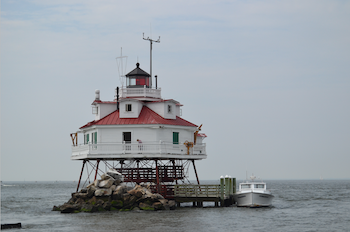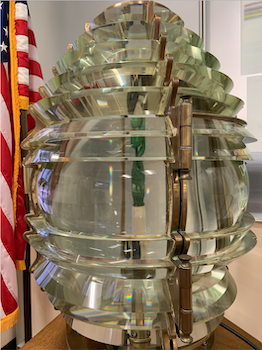FEATURE RELEASE: Legacy of Light: Last-of-a-kind lighthouse shines over Chesapeake Bay
U.S. Coast Guard sent this bulletin at 05/20/2019 12:03 PM EDT
| Feature Release |
May. 20, 2019 |
Legacy of Light: Last-of-a-kind lighthouse shines over Chesapeake Bay
Editors' Note: Click on images to download high resolution version.
ANNAPOLIS, Md. – The Thomas Point Shoal Light is the last screw-pile lighthouse on its original foundation in the United States and the last lighthouse that Coast Guardsmen served in on the Chesapeake Bay
Until 1986, U.S. Coast Guardsmen served on the offshore light that is located south of Annapolis, Maryland’s state capital.
The unique hexagonal screw-pile lighthouse was constructed in 1875 and fixed to the bottom of the Chesapeake Bay using a technique developed by Alexander Mitchell, an Irish lighthouse designer. The world’s first screw-pile lighthouse was lit in England in 1840.
Today, the U.S. Coast Guard still maintains the Thomas Point Light but the lighthouse structure was transferred to the City of Annapolis, Anne Arundel County, the Annapolis Maritime Museum and the U.S. Lighthouse Society in 2004. Named a National Historical Landmark in 1999, the Thomas Point Lighthouse is one of only 12 lighthouses in the U.S. to earn this high honor.
“The lighthouse marks the shoals at the entrance to Annapolis,” said Senior Chief Petty Officer John Kopp, the officer-in-charge of Aids to Navigation Team Baltimore, the team that maintains the light.
Kopp said the other Chesapeake Bay screw-pile lighthouses have been destroyed or moved to shore-side museums. A native of Philadelphia, Kopp leads the 20-person ATON team that maintains 508 primary Aids to Navigation, including six major lights and 42 range lights.
The U.S. Lighthouse Society hosts the tours of the Thomas Point Lighthouse between June and October every year. The tours depart from the Annapolis Maritime Museum.
According to Jeff Gales from the U.S. Lighthouse Society Headquarters, more than 2,000 people have visited the lighthouse since it first opened for tours in 2007.
“The Thomas Point Shoal project is a special and unique partnership between us, Anne Arundel County and the Annapolis Maritime Museum,” said Gales, who has worked at the U.S. Lighthouse Society Headquarters for 14 years.
Chief Warrant Officer Christopher Runt, the Coast Guard Sector Maryland-National Capital Region Aids to Navigation officer, said screw-pile lighthouses were ideally suited for the 180-mile-long Chesapeake Bay.
“One of the things that makes this region unique is that most of our work is on an estuary and the 150 rivers and streams that feed into it,” said Runt. “We also are located in a region where we contend with the damage done by both hurricanes in the summer and ice in the winter.”
In the past, ice floes wreaked havoc on the screw-pile lighthouses on the Chesapeake Bay. Ice has damaged, destroyed and sometimes set them adrift. In 1881, the Sharps Island Lighthouse was knocked off its foundation by an ice floe and drifted for more than 16 hours with its keepers still inside until it ran aground almost five miles away.
Over the years, rock rip-rap and ice breakers were installed to protect the Thomas Point Light from ice floes.
“The Thomas Point Shoal Lighthouse was intentionally designed to withstand the forces that ice puts on our structures,” said Runt. “The rock rip-rap was added to shield the legs from the moving ice.”
The cottage style lighthouse building supports the cupola light room that housed a 440-pound 4th order Fresnel lens until the light was automated in 1986. Today, the solar-powered LED light shines a white light 16 nautical miles and a red light 11 nautical miles.
The Fresnel lens that was used in the lighthouse now marks the entrance to Sector Maryland-National Capital Region Office
“The lens represents our shared history, both ATON and maritime, on the Chesapeake Bay,” said Runt. “Our current ATON crews are trusted to maintain the Aids to Navigation with the same dedication as the crews that have come before us for the last 230 years.”
###




